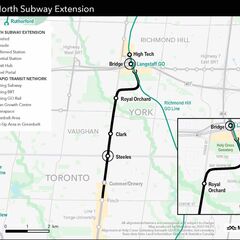Sagaris88
New Member
Actually a funny thing I've noticed about that black line curvy alignment map you showed. That's the map that Metrolinx gave to the media, that all the news websites used and is the main image for the Yonge North webpage on Metrolinx. That map does not exist in the Initial Business Case they released on the same day. That alignment is nowhere to be seen in it.Whoops my bad, I took another look and the document from 2013 that I linked to compared options 1, 2, and 2a instead of 1, 2, and 3. So yes, it's new but I doubt it was any more involvement from him personally than a directive to "innovate" to stay within a project budget and avoid unnecessary blowback.
This is Metrolinx's curve
View attachment 309398
Eyeballing it looks like a ~430 meter curve, which is already not great.
View attachment 309404
This is your alignment, the curve seems to be a little over ~150 meters. The cemetery is only ~300 meters wide and you are turning more than ~110 degrees, so for you to do the turn entirely within the cemetery means that <300 meters is the maximum minimum turn radius. But at that point you would just be cutting across it, not staying to the one end.
View attachment 309397
So yes, the curve is tighter with your alignment, which is natural when you only have a strip of land to work with vs. an entire neighbourhood to tunnel under.
The the bigger question is: You've avoided the disruption of tunnelling 25 meters below some people's homes to instead:
- Create an at-grade corridor running through those same people's backyards
- Eliminate the potential "rumbling" of deep underground trains and replace it with the screech of trains navigating a tight curve above ground (curves are responsible for almost all the noise and wear-and-tear on tracks)
- Carve up a good chunk of the cemetery for the TBM extraction point, portal, curve and at-grade corridor
I wasn't trying to do a reductio ad absurdum on your post, I was suggesting what I thought was a better option if the cemetery can be moved. The difference between option 3 and your alignment is that option 3 (the original, unrefined option 3 from the IBC) went under the cemetery and came at-grade in the CN corridor, so it doesn't involve moving bodies. It might be worth calculating what the cost savings are of having a trench through the cemetery vs. tunneling around it. If we save $400 million in construction costs and the Archdiocese is willing to accept $100 million in compensation for moving the cemetery across the street, it would be worth negotiating a settlement.
I'm suggesting moving it to Bantry, so it would be spaced evenly between Highway 7 and 16th Avenue. The two stations could have overlapping walksheds in the RHC area and "bookend" the development there. It would put it next to a bunch of highrises, not single family housing. But it would lose the direct link with High Tech road. High Tech road and Highway 7 are ~400 meters apart, so it's not really possible to have subway stops serve both without being close together.
I live near to this cemetery, and sometimes jog through it.
View attachment 309389
I'll admit that I would prefer if it had more water and mature trees as a park. And it has operating hours, which is a limitation that Toronto parks don't have. But I wouldn't consider it a landfill leaking toxic chemicals.
View attachment 309406
San Francisco, in its history, hastily relocated most of its cemeteries. A lot of the gravestones ended up as landfill and you can find tombstones wash up on the beach.
These are the three alignments indicated in the IBC:
I totally understand where you are coming from, that from that popular image that Metrolinx showed with the alignment veering westward to make a long curve to go diagonally under the middle of the neighbourhood to then make another sweeping curve along the rail tracks. From that, I would agree with you that sharper alignments aren't possible. But from Metrolinx's own IBC, they don't have that sweeping alignment. They have 1) the original undergound alignment 2) the original undergound alignment but with Bridge Station instead of Longbridge 3) an alignment that goes straight up Yonge and then makes a sharper 90 degree turn east on the north end of the neighbouhood just south of the cemetery and a larger radius but still acute angle, almost 70ish degree turn toward the rail tracks and come out of a portal at the north edge of the cemetary and at-grade to into RHC. So according to Metrolinx, sharper corners are available to use. Ofc, I absolutely agree that my map could show bigger radii and I believe there is enough room for bigger radii as well.
So I have no idea why Metrolinx released that alignment map showing the sweeping curves to the media when it is not even in their IBC. Going to be confusing for community consultations. In a recent York Region news article, residents had an outcry because they saw that map all over the news that showed the alignment right through the neighbourhood. But that alignment isn't being studied. It is an outcry for nothing. At the most only a handful of houses will be dug underneath in Option 3. Which is why I proposed moving those curves northward a bit so the tunnels would be going under grave rather than houses.
So really, I just think Metrolinx is in a mess and they seem to not know what they are doing or at the very least don't know how to handle PR. Is it that map they released to the media showing large curves veering westward to east? Or is it one of those three alignments in the IBC?



















